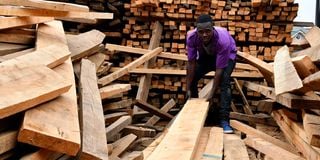Timber as a solution to Africa’s growing urbanisation problem

Mukenya Hardware worker Samuel Paul sorts through timber on September 2, 2022. There is a massive potential for timber use in construction.
Africa is the fastest growing continent in terms of urbanisation, sitting at 43 per cent and projected to rise to more than 50 per cent by 2050.
The rate and scale of urbanisation on the continent is challenging our infrastructure, massively limiting access to affordable housing.
“If we do not change our building methods, the technology and materials, this massive challenge will roll over us. We need scalability, affordability and quality at the same time,” Sebastian Dietzold, Chief Executive Officer of CPS, said.
Timber is the solution to the challenges of rapid urbanisation and carbon emission facing the planet today.
The construction industry is said to contribute to a third of global greenhouse gas emissions, hence the need for alternative, renewable and sustainable material like timber.
CPS is a Tanzanian-based real estate development company pioneering construction of modern buildings using sustainable timber.
The pioneer of Fumba town plans to carry out large-scale developments in Kenya’s neighbour to the south.
Green building developments require the use of sustainable material and project developers like CPS are responding by building using innovative engineered wood products (EWPs) such as cross-laminated timber (CLT) and glulam.
To address the challenges associated with urbanisation, CPS is building 300 to 400 housing units in Zanzibar.
According to the company, Zanzibar requires 6,000 affordable housing units while Dar es Salaam needs more than 70,000.
The use of engineered wood products for construction has many benefits.
Heat and cold insulator
The material is light and delivers at minimum the same structural strength as reinforced concrete.
A metre square of concrete is 2.7 tonnes while a metre square of CLT is merely 400 kilogrammes.
Engineered wood products are also climate-friendly.
One cubic metre of concrete emits a tonne of carbon dioxide while the same amount of CLT contains between 0.7 – 0.9 tonnes of carbon dioxide.
The material is a perfect heat and cold insulator, wood does not lose structural strength under fire, it provides accuracy for prefabricated timber buildings and can be erected faster than concrete houses.
There is massive potential for timber use in construction.
Tanzania, for example, has about 260,000 hectares of sustainably managed forest and around 52 per cent forest cover.
The country’s annual production of sawn timber is about 1.58 million metre square.
If 10 per cent of the wood is allocated to sustainable forestry, Tanzania alone can produce 42 million cubic metres of sawn timber every year, enough to feed the whole world.
Tree-growing for timber can generate income for individuals and communities.
The goal of CPS is to tell a story and change the perception on timber structure and the use of wood as a construction material.
CPS is developing the tallest hybrid timber tower, the Burj Zanzibar, with the aim of showcasing timber technology that is modern, beautiful, durable and sustainable.
Legal framework
The 96-metre high, 28-floor building will be a global architectural highlight, setting a benchmark of sustainable building in the 21 st century.
The 4,000-metre square tower will bind approximately 3,200 tonnes of carbon dioxide, its developers say.
Policies and legal frameworks play a significant role in increasing the uptake of timber as a structural material.
In Tanzania, for example, the National Engineered Wood Sector Development Framework, which was published in 2021, lays out policies for developing the timber industry.
CPS is engaging the Tanzanian government to build 10,000 homes every year and will soon launch a 5,000-unit project in Dar es Salaam.
Baraka Strato Mosha is a PR and Communications Specialist at CPS. Email: [email protected]




